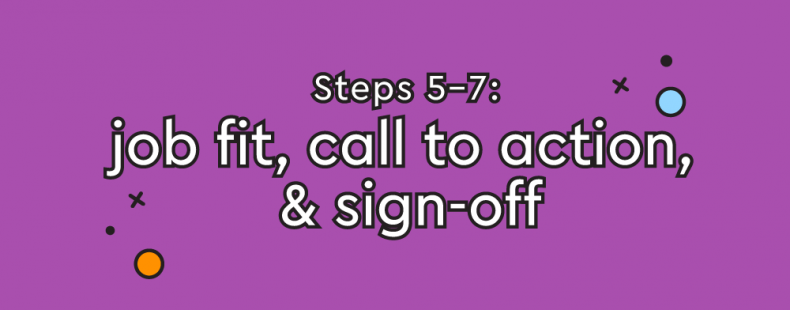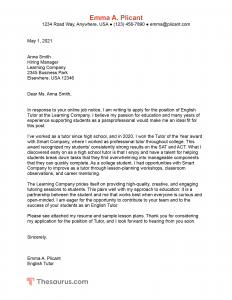Congratulations! You’re almost done writing what’s sure to be a stellar cover letter. But wait—you’ve got one more thing to do. You’ve got to proofread the letter and prepare the document for printing or sharing online.
Are you ready to do the toughest part of writing a cover letter? It’s inevitable—at some point, you have to sit down and write about yourself and your skills. But if you’re unsure of how to do that, we’ll help you through it. We’ll also make sure you’re closing the letter properly.
This article (Steps 5–7) in our comprehensive cover letter series will help you craft the body of the letter, making the strongest case for your application. You’ll move on to steps 8–9 to edit and finish the letter.
Step 1. Format Your Cover Letter
Step 2–4. Open The Cover Letter With A Proper Header, Greeting, And Memorable Introduction
✅ Step 5–7. Explain You’re Fit For The Job, Add A Call To Action, And End With The Right Sign-off
Step 8–9. Edit And Share Your Cover Letter
We’ve provided a sample cover letter you can use to follow along in this series and create your own. Click on the image below to expand it.
Step 4. Explain why you’re a good fit for the job in the body paragraphs
Once you’ve written an introduction, you’ll want to use a paragraph or two to explain why you’re a good fit for the position. Essentially, what skills or talents do you have and how would you plan on using them in this position? This section of the cover letter can be challenging to write without restating the information on your resume—and you don’t want to do that. We recommend keeping your resume on hand as you write this section. Think about what you can include that will provide more context and detail on what you have already listed in your resume.
Consider writing two paragraphs to explain your fit
One way to approach writing this section of the resume is to break it into two paragraphs. The first paragraph describes your skills, knowledge, and experience in relation to the job. The second paragraph describes why you are interested in the position. Of course, there may be some overlap between these two components.
Example body paragraphs
Consider this example as you work on your own cover letter:
Starting in high school, I began to work tutoring students from the local neighborhood. I found that I enjoyed helping them break down tasks that they found overwhelming into manageable components that they could quickly complete. While in college, I worked as a professional tutor at Smart Company, where I had opportunities to improve as a tutor through lesson-planning workshops, classroom observations, and career mentoring. In 2020, I won the Tutor of the Year award, in part because of my students’ consistently strong results on the SAT and ACT.
The Tutoring Company prides itself on providing high-quality, creative, and engaging tutoring sessions to students. This pairs well with my approach to education: it is a partnership between the student and me that works best when everyone is curious and open-minded. I am eager for the opportunity to contribute to your team and to the success of your students as an English Tutor.
In this example, you can see that the author touches on things that are most likely found on the resume, such as previous work experience and an award they won at that workplace. However, instead of simply restating the information, the cover letter provides context for it. For example, the author explains she “won the Tutor of the Year award” because of “my students’ consistently strong results on the SAT and ACT.” That kind of explanation and detail is what the cover letter is for.
The text also shares the author’s “approach to education.” In other words, she clearly describes what her values and interests in this kind of work are.
In the second paragraph, the author also makes it clear that she has researched the company and understands the position. She notes their goals of providing “high-quality, creative, and engaging tutoring sessions to students,” language that may have come from the company website. Demonstrating this kind of knowledge is one of the key elements that sets a strong cover letter apart from a weaker one.
Step 5. End with a call to action
The final paragraph of a cover letter includes a “call to action,” or a description of what you hope the audience (in this case, the hiring manager) will do after reading your letter.
Examples of calls-to-action
Typically, this concluding paragraph should only be 1–2 sentences long and include:
- A thank you
- A hope for a particular outcome, such as an interview or the position
If you’re not sure how to end a cover letter, this simple template will work in most situations:
- Please see attached my resume [and other application materials]. Thank you for considering my application for the position of [job title], and I look forward to hearing from you soon.
While it’s important that your cover letter overall be tailored to the job posting, your conclusion can be fairly standard.
Step 6. Use the right sign-off
Like any other letter or email, your cover letter needs to include a sign-off. Because this is a professional letter, you need to use a professional sign-off, followed by a comma, a few line breaks, and your full name. If you are sending a printed cover letter, you should sign your letter by hand.
Examples of sign-offs
Some examples of professional sign-offs are:
- Sincerely,
- Best,
- Thank you,
In most cases, “sincerely” works just fine. Avoid more familiar sign-offs like “Warm regards” or “Yours truly.”














